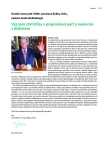Hypolipidemic and antihypertensive therapy in diabetic patients in the Czech Republic: notes on the VZP (General Health Insurance Company) Data
Authors:
Michaela Šnejdrlová 1,2; Richard Češka 1,2; Denisa Janíčková-Žďárská 3; Petr Honěk 4; Pavel Dušek 5,6; Tomáš Pavlík 5,6; Milan Kvapil 3
Authors‘ workplace:
Centrum preventivní kardiologie VFN Praha, vedoucí centra prof. MUDr. Richard Češka, CSc., FEFIM, FACP
1; III. interní klinika 1. LF UK a VFN Praha, přednosta prof. MUDr. Štěpán Svačina, DrSc., MBA
2; Interní klinika 2. LF UK a FN Motol Praha, přednosta prof. MUDr. Milan Kvapil, CSc., MBA
3; Všeobecná zdravotní pojišťovna České republiky, Praha, ředitel Ing. Zdeněk Kabátek
4; Ústav zdravotnických informací a statistiky, Praha, ředitel doc. RNDr. Ladislav Dušek, Ph. D.
5; Institut biostatistiky a analýz LF MU, MU, Brno, ředitel doc. RNDr. Ladislav Dušek, Ph. D.
6
Published in:
Vnitř Lék 2015; 61(Suppl 3): 30-37
Category:
Original Contributions
Overview
Diabetes mellitus and in particular type 2 diabetes mellitus is one of the most important risk factors of cardiovascular disease. To influence cardiovascular risk there is enormous important not only positive influence of glycemia, but also the treatment of diabetic dyslipidemia and hypertension. The present work provides an analysis of lipid-lowering and antihypertensive therapy for all diabetics registered with General Health Insurance Company in the period 2010–2013. In this time 866 570 patients with diabetes mellitus registered with General Health Insurance Company were treated, the majority of them were diabetics independent on insulin. Approximately half of the patients were observed by dialectologists and half of them by the doctors of other specialization. Out of antihypertensive medication, patients were most often treated by drugs that affect the renin-angiotensin system, as well as beta-blockers and diuretics. Prescription of the lipid-lowering therapy, especially prescription of statins, in accordance with the guidelines, is increasing, but remains insufficient (at 2013 43.6% diabetics treated by dialectologists and 51.3% diabetics treated by GP´s didn´t have lipid lowering therapy). Inadequate use of combination lipid-lowering therapy was recorded too, still represented mainly by combination of statin and fibrate, but in coming years we expect (based on the positive results of the subanalysis IMPROVE-IT study), an increase of combination therapy statin and ezetimibe.
Keywords:
diabetes mellitus type 2 – diabetic dyslipidemia – ezetimibe – cardiovacular risk – statins
Sources
1. Diabetes UK. Cardiovascular disease. Dostupné z WWW: <https://www.diabetes.org.uk/>. (poslední přístup 19.04.07).
2. American Association of Clinical Endocrinologists. State of Diabetes Complications in America http://multivu.prnewswire.com/mnr/AACE/2007/docs/Diabetes_Complications_Report.pdf (poslední přístup May 19, 2013).
3. Folsom AR, Rasmussen ML, Chambless LE et al. Prospective associations of fasting insulin, body fat distribution, and diabetes with risk of ischemic stroke. The Atherosclerosis Risk in Communities (ARIC) Study Investigators. Diabetes Care 1999; 22(7): 1077–1083.
4. Sattar N. Revisiting the links between glycaemia, diabetes and cardiovascular disease. Diabetologia 2013; 56(4): 686–695.
5. American Diabetes Association. Management of dyslipidemia in adults with diabetes. Diabetes Care 2011; 34: S12-S47.American Diabetes Association. Dyslipidemia Management in Adults With Diabetes. Diabetes Care 2004; 27(Suppl 1): s68-s71.American Diabetes Association. Standards of Medical Care in Diabetes—2011. Diabetes Care 2011; 34(Suppl 1): s11-s61.
6. Baigent C, Blackwell L, Emberson J et al. Efficacy and safety of more intensive lowering of LDL cholesterol: a meta-analysis of data from 170,000 participants in 26 randomised trials. Lancet 2010; 376(9753): 1670–1681.
7. Kearney PM, Blackwell L, Collins R et al. Efficacy of cholesterol-lowering therapy in 18,686 people with diabetes in 14 randomised trials of statins: a meta-analysis. Lancet 2008; 371(9607): 117–125.
8. Perk J, De BG, Gohlke H et al. European guidelines on cardiovascular disease prevention in clinical practice (version 2012): the fifth joint task force of the European society of cardiology and other societies on cardiovascular disease prevention in clinical practice (constituted by representatives of nine societies and by invited experts). Int J Behav Med 2012; 19(4): 403–488.
9. Reiner Z, Catapano AL, De BG et al. ESC/EAS Guidelines for the management of dyslipidaemias: The Task Force for the management of dyslipidaemias of the European Society of Cardiology (ESC) and the European Atherosclerosis Society (EAS). Eur Heart J 2011; 32(14): 1769–1818.
10. Rydén L, Grant PJ, Anker SD et al. ESC Guidelines on diabetes, pre-diabetes, and cardiovascular diseases developed in collaboration with the EASD: The Task Force on diabetes, pre-diabetes, and cardiovascular diseases of the European Society of Cardiology (ESC) and developed in collaboration with the European Association for the Study of Diabetes (EASD). Eur Heart J 2013; 34(39): 3035–3087.
11. Cifkova R, Skodova Z, Bruthans J et al.Longitudinal trends in major cardiovascular risk factors in the Czech population between 1985 and 2007/8. Czech MONICA and Czech post-MONICA. Atherosclerosis 2010; 211(2): 676–681.
12. Ceska R, Snejdrlova M, Prusikova M et al. Complex Approach in the Decrease of cardiovascular Risk in Daily Practice, the VARO study. Circulation 2013; 128: A11969.
13. Češka R, Vaclová M. VATARO- příběh pokračuje. Uspořádání a pilotní výsledky studie. Kapitoly z kardiologie 2015; 7(2): 56–60.
14. Cannon PP, Blazing MA, Giugliano RP et al. Ezetimibe Added to Statin Therapy after Acute Coronary Syndromes. N Engl J Med 2015; 372(25): 2387–2397.
15. Sattar N, Taskinen MR. Statins are diabetogenic – myth or reality? Atherosclerosis Suppl 2012; 13(1): 1–10.
16. Hradec J, Bultas J, Kmínek A et al. Jak se léčí statiny v České republice? Výsledky průzkumu STEP. Cor Vasa 2011; 53(10): 527–534.
Labels
Diabetology Endocrinology Internal medicineArticle was published in
Internal Medicine

2015 Issue Suppl 3
Most read in this issue
- Incidence of amputations among patients with diabetes mellitus in the Czech Republic from 2010 to 2014
- The mortality of patients with diabetes mellitus using oral antidiabetic drugs in the Czech Republic decreased over the decade of 2003–2013 and came closer to the population average
- Monitoring of diabetes compensation in patients treated with an insulin pump in the Czech Republic
- Clinical and economic benefits of the new antidiabetic drugs in the Czech Republic
